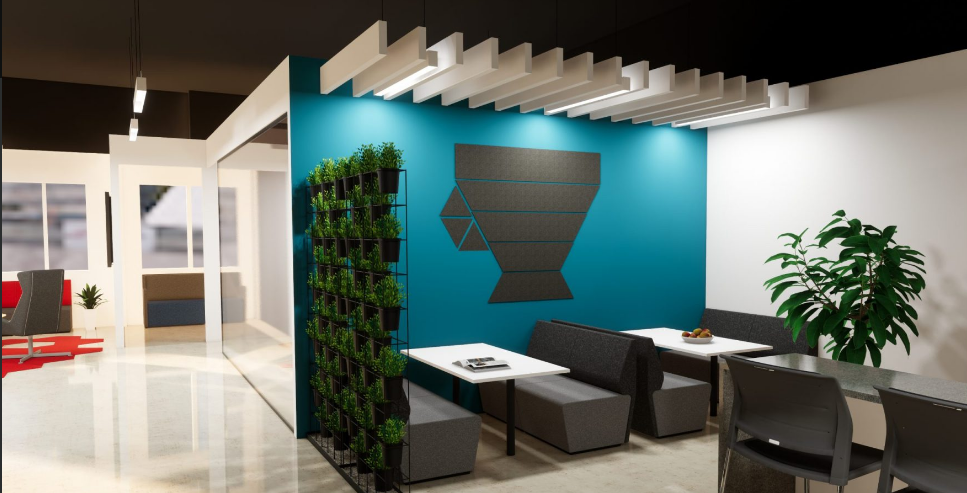Acoustic Panels on Wall

Acoustic panels on walls are a popular solution for improving the acoustics of commercial spaces, such as offices, conference rooms, restaurants, and bars. With the rise of open-plan offices and shared workspaces, the need for acoustic solutions has become more important than ever before. Poor acoustics can lead to a range of issues, including reduced productivity, low morale, and even health problems.
Acoustic wall panels are modular pieces that contractors can easily install and are made of PET acoustic felt. This sustainable material is highly effective at absorbing sound. These panels come in a range of sizes, shapes, and colours, allowing them to be customized to fit any space.
By reducing noise levels and improving speech clarity, acoustic panels can create a comfortable and productive workspace that benefits everyone. In this blog post, we will explore the benefits of acoustic panels for walls and provide tips on choosing the right panels for your commercial space.
What Should You Keep in Mind While Selecting Acoustic Panels?
When selecting acoustic panels for your commercial space, there are a few key factors to remember. Here are some important things to consider:
Acoustic Performance: The acoustic performance of the panels is one of the most important factors to consider. Look for panels with a high noise reduction coefficient (NRC) rating, as this indicates that they are highly effective at absorbing sound.
Design: Consider the design of your commercial space and choose panels that complement the aesthetic of your space. Acoustic panels come in a range of sizes, shapes, and colours, so you should be able to find panels that fit your design requirements.
Material: Acoustic panels can be made from various materials, including foam, fiberglass, and PET acoustic felt. Consider the durability and sustainability of the material when making your selection.
Installation: Consider the ease of installation when choosing acoustic panels. Contractors can easily install some panels, while others may require more extensive installation methods.
Cost: Finally, consider your budget when choosing acoustic panels. While they are a cost-effective solution, some panels may be more expensive than others, so choose panels that fit within your budget.
Do Acoustic Panels for Walls Work?
Acoustic panels for walls are highly effective at improving the acoustics of a space by reducing reverberation and echo. These panels are designed to absorb sound waves, preventing them from bouncing around the room and creating unwanted noise.
When properly installed, acoustic panels can significantly reduce noise levels, improve speech clarity, and create a more comfortable and productive environment.
It’s important to note that the effectiveness of acoustic panels will depend on factors such as the size of the space, the number and placement of the panels, and the type and thickness of the panel material. Therefore, it’s recommended to consult with an acoustic professional and choose high-quality panels like those offered by Altispace for optimal results.
Do I Need to Cover the Entire Wall With Acoustic Panels?
It is not necessary to cover the entire wall with acoustic panels, but the amount and placement of the panels will depend on the specific needs of your space. In some cases, covering the entire wall with panels may be necessary to achieve the desired acoustic results, while in other cases, a smaller number of panels placed strategically throughout the space may be sufficient.
When determining the placement of acoustic panels, it is important to consider the sources of noise in your space and the areas where sound is most problematic. For example, if you have a large open-plan office with a lot of hard surfaces, placing acoustic panels strategically around workstations and in high-traffic areas may be the most effective solution. Alternatively, if you have a conference room where speech clarity is important, panels placed around the perimeter of the room may be more effective.
In general, it is best to work with an acoustic consultant or contractor who can assess the specific needs of your space and recommend the most effective placement and amount of acoustic panels. They can also help you choose the right type of panels for your space and ensure that they are installed properly to achieve the desired acoustic results.
What is the Difference Between Acoustic Panels and Soundproofing?
Acoustic panels and soundproofing are two different solutions for improving the acoustics of a space. Acoustic panels are designed to absorb sound and improve speech clarity by reducing echoes and reverberations in a room. They are often installed on walls, ceilings, and even floors, and come in a variety of sizes, shapes, and colors to complement any design aesthetic. On the other hand, soundproofing is designed to prevent sound from entering or leaving a space. Soundproofing solutions may include insulation, double-paned windows, and other materials that block sound transmission.
While both solutions can improve the acoustics of a space, acoustic panels are more focused on improving the quality of sound within a room. At the same time, soundproofing is focused on blocking sound from entering or leaving a space altogether. Depending on your specific needs, you may use one solution or a combination of both to achieve optimal results.
Final Verdict
Acoustic panels for walls are an effective solution for improving the acoustics of commercial spaces. They can significantly improve speech clarity, reduce noise levels, and create a more comfortable and productive environment for employees and customers. When choosing acoustic panels, it is important to consider factors such as acoustic performance, design, and budget.
Altispace is a reliable manufacturer of high-quality acoustic panels that can be mounted on walls. Their PET acoustic felt panels are not only effective at absorbing sound, but also sustainable and customizable to fit any space. By choosing Altispace for your acoustic panel needs, you can improve your commercial space’s acoustics while promoting sustainability and aesthetics.
Back
 Proud Member of ARCAT
Proud Member of ARCAT